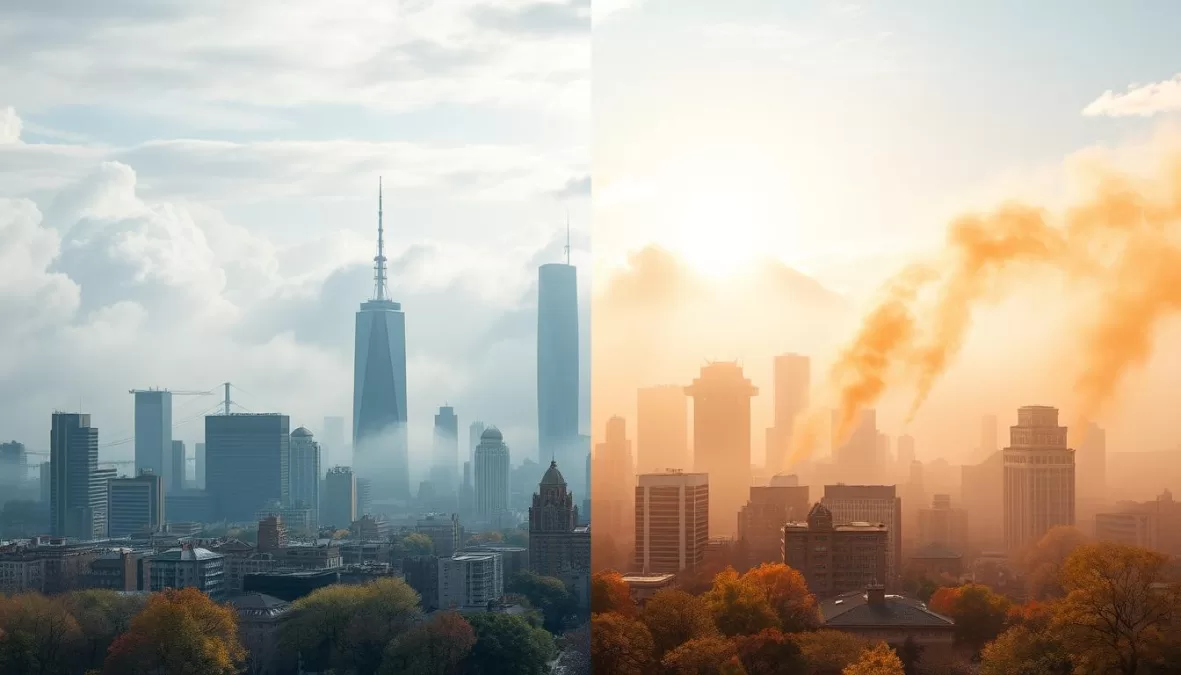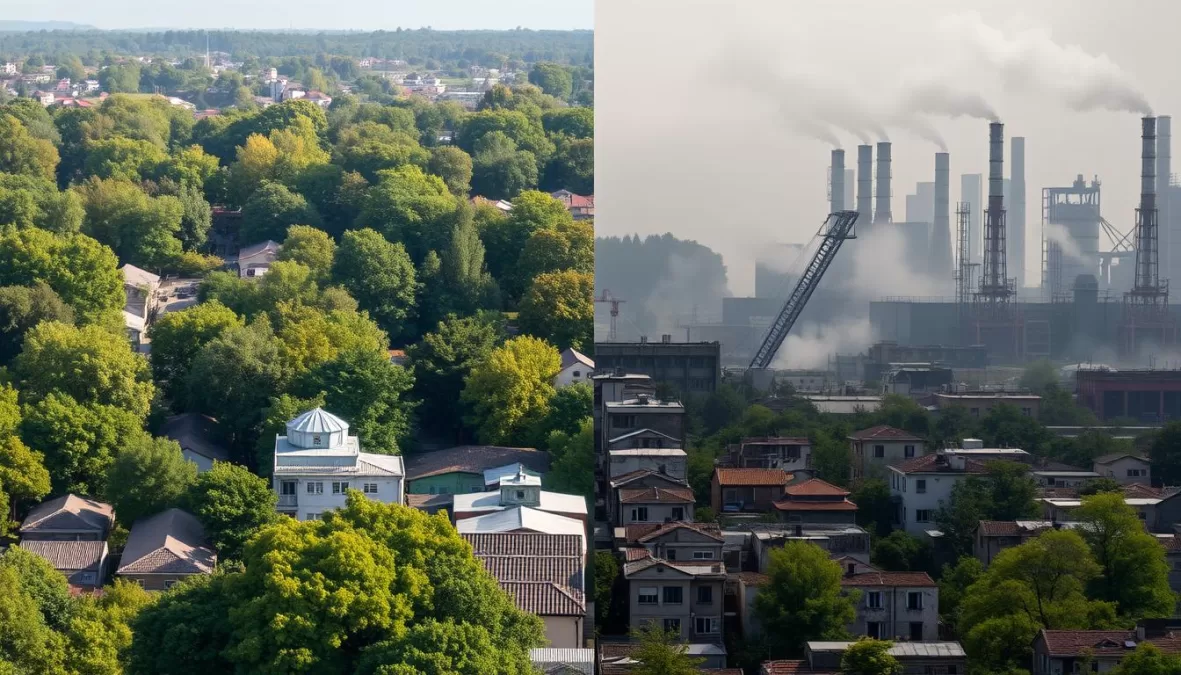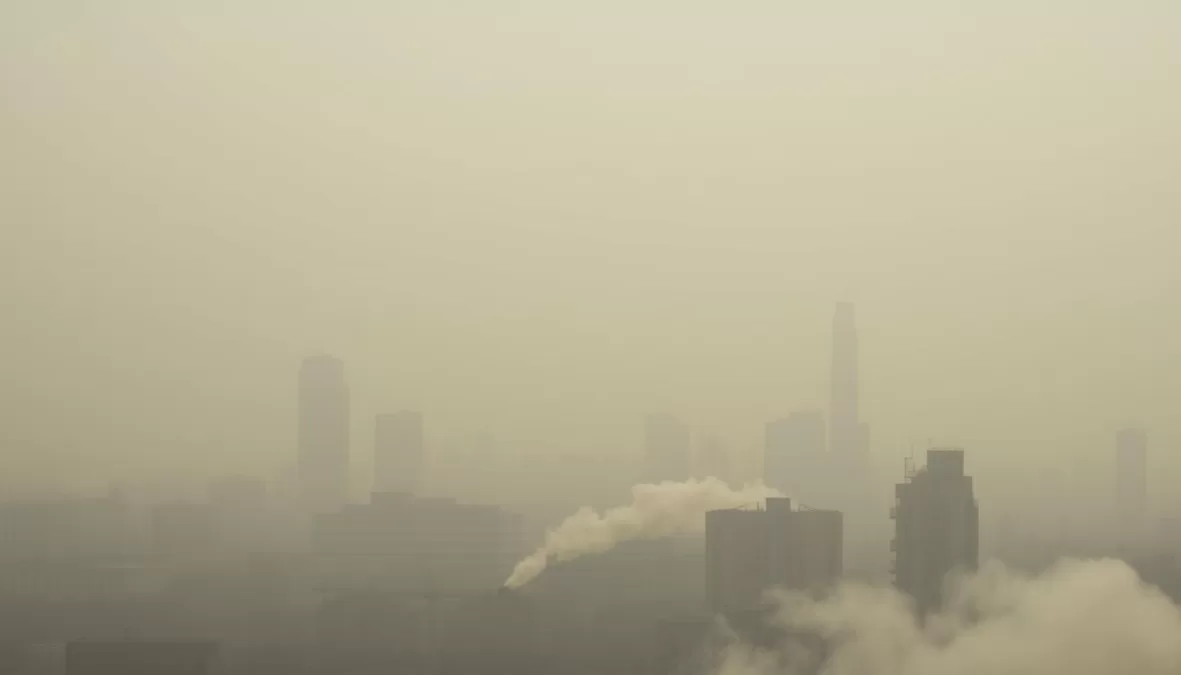The world’s top 10 most polluted cities face a severe air quality crisis. Delhi, India, leads with an Air Quality Index (AQI) of 396. This is far beyond the World Health Organization’s (WHO) safe levels.
Kolkata, India, and Sarajevo, Bosnia Herzegovina, follow with AQIs of 266 and 264. Dhaka, Bangladesh, Mumbai, India, and Hanoi, Vietnam, also struggle with poor air quality. Karachi, Pakistan, Tehran, Iran, Lahore, Pakistan, and Pristina, Kosovo, round out the list. All these cities have AQIs that range from “Unhealthy” to “Hazardous”.
Key Takeaways
- Delhi, India tops the list of the world’s most polluted cities with an AQI of 396.
- Kolkata, India and Sarajevo, Bosnia Herzegovina follow closely with AQIs of 266 and 264 respectively.
- The top 10 list includes several major urban centers in South Asia and Eastern Europe, all facing severe air quality challenges.
- AQI levels in these cities range from “Unhealthy” to “Hazardous”, posing significant health risks to residents.
- Addressing the air pollution crisis in these regions requires concerted efforts from governments, industries, and communities.
Understanding Global Air Pollution Crisis
The global air pollution crisis is complex. It’s important to know the key metrics and guidelines for air quality. The Air Quality Index (AQI) helps us understand air quality levels. It ranges from 0-50 (Good) to 301+ (Hazardous).
This index is crucial for knowing the health impacts of air pollution.
What is the Air Quality Index (AQI)?
The AQI measures air pollutants like particulate matter, ozone, and carbon monoxide. It shows the health risks of different air pollution levels. These risks range from minimal to severe respiratory and cardiovascular effects.
Health Impact Categories of Air Quality
The AQI categories show different health concerns. “Good” air quality has little risk. As the AQI increases, so does the risk to health.
“Moderate” air quality is risky for sensitive groups. “Unhealthy” and “Hazardous” air quality are dangers to everyone.
Global Air Quality Standards
The World Health Organization (WHO) sets safe air pollutant levels. They recommend a PM2.5 annual mean of 10 μg/m³ and a 24-hour mean of 25 μg/m³. Sadly, many cities exceed these levels, with some PM2.5 levels up to 10 times the WHO’s recommendations.
The global air pollution crisis needs urgent action. Knowing the AQI, health impacts, and WHO standards helps us tackle this issue. We aim for cleaner, safer air for everyone.
| AQI Range | Health Impact Category | Health Implications |
|---|---|---|
| 0-50 | Good | No adverse health effects expected |
| 51-100 | Moderate | Acceptable air quality, but may be a risk for sensitive individuals |
| 101-150 | Unhealthy for Sensitive Groups | Increased risk of respiratory symptoms for sensitive individuals |
| 151-200 | Unhealthy | Increased risk of respiratory symptoms and cardiovascular effects for the general population |
| 201-300 | Very Unhealthy | Significant risk of respiratory symptoms and cardiovascular effects for the general population |
| 301+ | Hazardous | Serious risk of respiratory and cardiovascular effects for the general population |
Factors Contributing to Urban Air Pollution
Urban areas worldwide struggle to keep the air clean. Industrial emissions, vehicle exhaust, urbanization, and fossil fuel use are key factors. Understanding these dynamics is vital for solving the air pollution problem.
Industrial activities are a big source of pollution. Chemical plants, steel mills, and power plants release harmful pollutants. These pollutants can badly affect the air quality in cities.
Vehicle exhaust is another major pollutant. Cars and trucks, powered by fossil fuels, release harmful gases. These gases, like nitrogen oxides and carbon monoxide, are especially harmful in crowded cities.
Urbanization has made air pollution worse. More people moving to cities for jobs means more pollution. Construction and energy use for heating and electricity add to the problem.
Fossil fuels are a big part of the pollution problem. Burning coal, oil, and gas releases harmful pollutants. These pollutants can harm people’s health and stay in the air for a long time.
To fix urban air pollution, we need a team effort. Policymakers, industry, and the public must work together. We need better rules, new technologies, and sustainable ways to live and travel in cities.
| Pollutant | Major Sources | Health Impacts |
|---|---|---|
| Particulate Matter (PM2.5, PM10) | Vehicle emissions, industrial activities, construction, heating | Respiratory problems, cardiovascular diseases, lung cancer |
| Nitrogen Oxides (NOx) | Vehicle emissions, power plants, industrial processes | Respiratory issues, decreased lung function |
| Sulfur Oxides (SOx) | Power plants, industrial processes, shipping | Respiratory symptoms, acid rain, environmental damage |
| Carbon Monoxide (CO) | Incomplete combustion of fossil fuels, vehicle emissions | Headaches, dizziness, reduced oxygen delivery to tissues |
| Volatile Organic Compounds (VOCs) | Paints, solvents, fuels, industrial processes | Eye, nose, and throat irritation, nausea, headaches |
Urban air pollution comes from many sources. We need a wide-ranging solution. This includes better policies, new technologies, and raising awareness to make cities cleaner and healthier.
“Improving air quality is not just an environmental issue, but a matter of public health and economic well-being. By tackling the root causes of urban air pollution, we can create healthier and more livable cities for all.”
Top 10 Most Polluted Cities in the World
The air pollution crisis is getting worse, and it’s hitting cities hard. The list of the world’s most polluted cities is alarming. Many cities struggle to keep the air clean enough to breathe.
Delhi, India (AQI: 396)
Delhi, India, tops the list with an Air Quality Index (AQI) of 396. This is a “hazardous” level of pollution. It’s a big health risk for Delhi’s people, who face poor air quality every day.
Kolkata, India (AQI: 266)
Kolkata, India, is second with an AQI of 266, or “very unhealthy.” This crowded city battles many pollution sources. These include industrial emissions and car traffic.
Sarajevo, Bosnia Herzegovina (AQI: 264)
Sarajevo, Bosnia Herzegovina, is also very polluted, with an AQI of 264. It’s “very unhealthy.” The city’s location and use of fossil fuels make air quality worse.
Other Cities in the Top 10
The rest of the top 10 includes Dhaka (AQI: 185), Mumbai (AQI: 179), Hanoi (AQI: 177), Karachi (AQI: 165), Tehran (AQI: 160), Lahore (AQI: 160), and Pristina (AQI: 158). These cities often have air that’s not safe to breathe. This is a big health risk for their people and harms the environment.
The air pollution in these cities is a serious problem. We need strong actions to fix it. The fight against air pollution is urgent. We must focus on these cities to protect people’s health and the environment.
Health Implications of Living in Polluted Cities
Living in very polluted cities can be very harmful. People face serious health risks. These include respiratory diseases, heart problems, and long-term health effects.
In places like Delhi and Kolkata, air quality is very bad. This leads to more asthma, COPD, and heart diseases. The World Health Organization says air pollution causes 4.2 million early deaths each year. Most of these are due to heart disease and stroke.
Being exposed to pollution for a long time can shorten your life. The majority of the premature deaths in low- and middle-income countries were concentrated in the WHO South-East Asia and Western Pacific Regions. This is where many polluted cities are found.
Respiratory Diseases and Air Pollution
Air pollution badly affects the lungs. It can cause asthma, COPD, and lung cancer. Studies link urban living and air pollutants to more asthma and worse symptoms.
Cardiovascular Impacts
Air pollution, especially small particles, harms the heart. These particles can make blood vessels worse and increase heart disease risk. Older people may also see their good cholesterol levels drop because of pollution.
Long-term Health Effects
Living in polluted cities has more health risks than just lung and heart problems. Air pollution can also lead to cancer. It can even harm babies in the womb and increase the risk of childhood asthma and cerebral palsy.
The health dangers of air pollution are a big worry worldwide. Most of the harm is in poorer countries. We need governments, industries, and people to work together. We must find ways to control pollution and make cities healthier.
Industrial Impact on Urban Air Quality
The air in our cities is often polluted. Industrial activities, vehicle emissions, and energy production are the main culprits. We see how manufacturing, vehicle pollution, and the energy sector worsen the problem.
Manufacturing Emissions
Manufacturing in cities like Delhi and Kolkata pollutes the air a lot. These places release harmful particles, sulfur dioxide, and nitrogen oxides. It’s key to reduce these emissions to clean our air.
Vehicle Pollution
Vehicle pollution is a big problem in the world’s most polluted cities. Old cars and bad fuel quality increase harmful pollutants. We need cleaner cars and stricter rules to fix this.
Energy Production
The energy sector, especially coal plants, pollutes cities like Delhi and Dhaka. Burning fossil fuels releases harmful pollutants. Switching to cleaner energy is vital for better air quality.
To improve city air, we must tackle industrial, vehicle, and energy pollution. With the right strategies and rules, we can make our air clean and safe for everyone.
“Air pollution is a silent killer, and we must take immediate action to address this critical issue for the health and well-being of our communities.”
Seasonal Variations in Air Pollution
The air we breathe changes a lot with the seasons. In many cities, air quality gets worse in winter. This is because cold air traps pollutants near the ground.
In places like Delhi, things get even worse. Burning crops in nearby states in October and November makes the winter smog much worse.
But summer brings better air. Pollutants spread out more because of the wind and weather. This seasonal air quality fluctuations affects people’s health a lot.
It’s key for city leaders to understand these pollution patterns. They can then make plans to fight air pollution. By fixing the main causes, like how we farm and what industries do, we can make the air cleaner and healthier for everyone.
“The air we breathe is a fundamental part of our daily lives, yet its quality can vary dramatically depending on the time of year. Addressing these seasonal challenges is essential for improving the overall health and well-being of our communities.”

| Season | Air Quality Trends | Contributing Factors |
|---|---|---|
| Winter | Worse air quality | Temperature inversions, crop burning, industrial activities, residential heating |
| Summer | Improved air quality | Better air circulation, reduced industrial and agricultural activities |
Economic Impact of Air Pollution
Air pollution is a huge problem worldwide. In cities like Delhi and Kolkata, it costs a lot to treat illnesses caused by pollution. It also makes people miss work, costing billions of dollars each year.
Healthcare Costs
Air pollution causes 7 million deaths every year. This has a big economic impact. For example, Bakersfield, California, is very polluted. It has high levels of harmful particles in the air.
The cost of treating illnesses in Bakersfield is a big burden on the local economy.
Productivity Losses
Air pollution affects more than just health. It also makes people less productive at work. Nearly 70% of highly-skilled workers consider air quality important when choosing where to live and work.
People are also making more eco-friendly choices when buying things. This can change how different industries work. Strict rules, like fines for companies that break air quality laws, show the economic costs of pollution.
To tackle air pollution’s economic effects, we need many solutions. Governments, international groups, and companies must work together. By focusing on clean air, we can improve health and boost the economy for everyone.
Environmental Justice and Air Quality
In many polluted cities, poor neighborhoods suffer more from air pollution. This is because they are close to industrial sites or busy roads. This unfair situation harms the health of children and the elderly more.
The Guardian’s advanced modeling shows the top 10 polluted spots in the U.S. are in areas with more racial minorities. Studies say race is a better indicator of pollution exposure than income.
In Birmingham, Alabama, the most polluted areas are 95% Black. Atlanta’s pollution mirrors old maps that unfairly targeted certain areas. In St. Louis, the most polluted spots are 52% Black, all north of Delmar Boulevard.
Air pollution’s impact on poor communities is a worldwide problem. Delhi and Kolkata in India have some of the worst air pollution. It leads to 106 and 99 deaths per 100,000 people, respectively. Globally, unsafe air causes about 4 million early deaths yearly, with 25% in India.
Fighting for clean air for all is key to solving the air pollution crisis. Leaders must create policies that tackle this issue at its source.

Current Mitigation Efforts
As air pollution worldwide gets worse, governments and global groups are stepping up. They’re working on new ways to fight pollution. This includes making agreements and starting new projects to clean the air.
Government Initiatives
Cities worldwide are fighting air pollution. Delhi, India, has an “odd-even” car rule to cut down on cars. They also push for cleaner fuels like CNG.
Kolkata, India, is improving its buses and trains. They want people to use public transport more and drive less.
International Cooperation
The Paris Agreement is a big step towards solving climate change. It brings countries together to cut down on harmful emissions. But, making these changes happen in polluted cities is hard.
It shows we need to keep working together. We must have stronger rules and plans to clean the air. This is key to meeting our global environmental goals.
Future Projections and Trends
The air quality forecast is still a concern, even with some slight improvements in cities. Rapid urban growth in countries like India and China is a big challenge. Cities like Delhi and Kolkata aim to cut pollution, but they need to keep working and use new tech.
Recent data shows 83 out of 100 cities with the worst air last year were in India. Also, only 9% of over 7,800 cities globally met WHO PM2.5 standards. South Asia, especially India, Pakistan, and Bangladesh, has the worst air.
Urban development plans worldwide must focus on improving air quality for health. Fossil fuel pollution causes 5.1 million deaths yearly. Most places, 92.5% of locations, exceeded WHO’s PM2.5 guidelines. Africa is also a concern, with only 24 out of 54 countries having enough data.
But, there’s hope. Some very polluted countries, like Chad, were not ranked in 2023 due to lack of data. This shows a growing awareness. In the U.S., ozone pollution has gotten better, with 2.4 million fewer people exposed to unhealthy ozone.
To tackle air quality and pollution, we need a mix of government actions, new tech, and global teamwork. This is key to making our cities healthier and more sustainable.
“Addressing air pollution is not just an environmental issue, but a matter of social and economic justice. We must ensure that all communities, regardless of their socioeconomic status, have access to clean air and a healthy environment.”
Conclusion
The air quality crisis is severe, with pollution in the world’s top 10 most polluted cities alarming. We need a strong plan to tackle this issue. This plan should include strict rules, new technologies, and green city designs.
Air pollution harms our health and economy, making it key to improve air quality. We must act together, locally and globally. This includes making and enforcing good policies and teaching people to care for the environment.
By focusing on green cities, clean energy, and eco-friendly transport, we can fight air pollution. This effort is vital for our health and for a better future. It’s about making sure our cities are safe and healthy for everyone.





